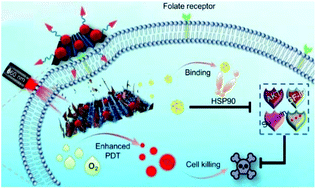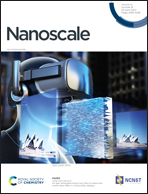Integration of a porous coordination network and black phosphorus nanosheets for improved photodynamic therapy of tumor†
Abstract
Selectively attenuating the protection offered by heat shock protein 90 (HSP90), which is indispensable for the stabilization of the essential regulators of cell survival and works as a cell guardian under oxidative stress conditions, is a potential approach to improve the efficiency of cancer therapy. Here, we designed a biodegradable nanoplatform (APCN/BP-FA) based on a Zr(IV)-based porphyrinic porous coordination network (PCN) and black phosphorus (BP) sheets for efficient photodynamic therapy (PDT) by enhancing the accumulation of the nanoplatforms in the tumor area and attenuating the protection of cancer cells. Owing to the favorable degradability of BP, the nanosystem exhibited accelerated the release of the HSP90 inhibitor tanespimycin (17-AAG) and an apparent promotion in the reactive oxygen species (ROS) yield of PCN as well as expedited the degradation of the PCN-laden BP nanoplatforms. Both in vitro and in vivo results revealed that the elevated amounts of ROS and reduced cytoprotection in tumor cells were caused by the nanoplatforms. This strategy may provide a promising method for attenuating cytoprotection to aid efficient photodynamic therapy.



 Please wait while we load your content...
Please wait while we load your content...